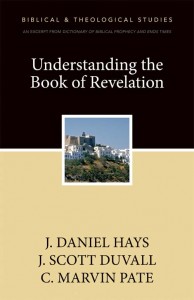 Understanding the Book of Revelation is a brief ebook, a Zondervan Digital Short, that was previously published as an entry in The Dictionary of Biblical Prophecy and End Times. It can be easily read through in one sitting, yet it is a wonderfully helpful overview of the book of Revelation that would serve as a great introduction to anybody wanting to study or teach through the last book in the Bible. And at a price of $1.99 it is easy on the wallet as well.
Understanding the Book of Revelation is a brief ebook, a Zondervan Digital Short, that was previously published as an entry in The Dictionary of Biblical Prophecy and End Times. It can be easily read through in one sitting, yet it is a wonderfully helpful overview of the book of Revelation that would serve as a great introduction to anybody wanting to study or teach through the last book in the Bible. And at a price of $1.99 it is easy on the wallet as well.
The authors argue that the book combines three different genres: letter, prophecy, and apocalyptic. Concerning the date, they believe it was written during the time of Domitian. They offer a helpful take on the purpose of Revelation:
The purpose of Revelation is to comfort those facing persecution because of their faithfulness to Jesus and to warn those compromising with the world system out of faithlessness to Jesus. Revelation answers the question, “Who is Lord?” During times of oppression and persecution, the righteous suffer and the wicked seem to prosper. This begs the question, “Is God still on his throne?” Revelation says that in spite of how things appear, Caesar is not Lord and Satan is not Lord; rather, Jesus is Lord and he is coming soon to restore his creation and establish his eternal kingdom. Satan, sin, and death will not have the final word.
The main message of this final book of Scripture is “God wins!” Those facing persecution have their hearts and minds immersed in hope and their eyes opened to see God’s future. Those who are selling their souls to the pagan powers are shown God’s future so as to shock them into repentance. The purpose of Revelation is to transform the audience to live in faithful obedience to Jesus. (Kindle Locations 105-113)
Furthermore, they argue for an “eclectic approach” that takes the strengths and leaves the weaknesses of the preterist, historicist, futurist, and idealist approaches.
The authors next offer a helpful overview or outline of Revelation:
(1) Introduction (1:1–20)
(2) Messages to the seven churches (2:1–3:22)
(3) A vision of the heavenly throne room (4:1–5:14)
(4) The opening of the seven seals (6:1–8:1)
(5) The sounding of the seven trumpets (8:2–11:19)
(6) The people of God versus the powers of evil (12:1–14:20)
(7) The pouring out of the seven bowls (15:1–16:21)
(8) The judgment and fall of Babylon (17:1–19:5)
(9) God’s ultimate victory (19:6–22:5)
(10) Conclusion (22: 6–21)
They provide nice summaries of each of these sections along the way. The next section offers summaries of the various theological themes of Revelation.
Finally, their conclusion is worthy of consideration:
Whenever false religion partners with ungodly political power to form a system that demands total allegiance, the historical situation faced by John’s first readers finds a parallel. The responses will vary. For those who stand strong and face persecution, Revelation offers a prophetic perspective on what is real. The result is a hope that empowers perseverance. For those who are compromising with the evil system to avoid trouble, Revelation offers a sober warning of coming judgment. The intended result is repentance leading to life.
Revelation no doubt offered hope to its original readers. The book also contains significant portions that look to future fulfillment. As the final chapter in God’s plan to defeat the powers of evil, he will reverse the curse of sin, restore his creation, and live among his people forever in perfect community. For those living between the first century and the last century, Revelation supplies an empowering vision for following Jesus. While many of the details of this fascinating book remain a mystery, the main idea is clear: God wants his people to live faithfully in a fallen world until Jesus returns. To fulfill God’s purpose, people need a vision powerful enough to transform how they think and how they live. They need to hear afresh the message of Revelation. (Kindle Locations 348-357)
This is a very helpful little work. Highly recommended.
